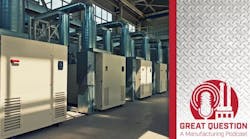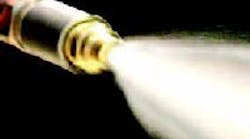State-of-the-art spray tips can be fabricated from high-density plastics rather than metal.
Closeup of end-of-arm tooling on a new forging robot.
Earlier this year, Rimrock Corp. acquired the assets of Lubrimation Inc., a supplier of die lubrication and automation equipment to the forging industry. Forging interviewed Mike Forster, who joined Rimrock as the company's new forging specialist. We asked what forgers could do to improve their die lubrication practices.
Identify what you see as the key trends in the forging industry affecting die lubrication.
The way we see it, North American forgers simply have to become more efficient to meet the competition from offshore forgers. They have to produce more pieces per hour. Efficient and effective die lubrication can play a role in boosting production rates.
As lubrication system suppliers, we have to offer equipment that provides shorter spray-cycle times. We're designing equipment that will cool and coat the die as fast as possible, then get out of the way. We don't want lubrication to be pacing the process—we'd rather have some other aspect of the operation determine the pace.
We're also working to provide equipment that is rugged and heavy duty. We're working with different materials to make sure that the equipment lasts longer.
Tell us about the new materials you are using.
There are problems with both wear and surface buildup with metal nozzles and tips.
We're using new, high-density plastics for nozzles and spray tips for longer life. They have a higher coefficient of friction than metals.
Graphite particles in a die lubricant are abrasive, even though they are very fine particles. They tend to wear out spray tips. With brass, aluminum, or strainless steel products, we can get only 600,000 to 700,000 cycles. We can get 1 million cycles without any problems with the new plastic materials.
Also, the lubricant tends to adhere to the interior walls of the nozzles and spray tips made of metal. That does not happen with plastics. With plastics, water can be used to clean out the nozzles and tips.
Longer-lasting nozzles and tips mean savings for forgers who use them.
What can you tell us about developments in designs of nozzles and tips?
The nozzle is where the lube and air come together and the tip is the exit point. We have developed tips that spray exactly the pattern we want to spray. We have also developed controls to turn on the spray at whatever exit point we want to spray from, and then turn it off again.
Our sprays provide cooling water and then die lube because water is much more efficient at cooling than the die lubricant itself.
We've developed an atomized spray that penetrates the thermal barrier next to the die surface and cools it faster. In fact, cooling the dies is becoming as important as coating them. The same atomized spray then coats the die surface faster, too.
All this is technology that we are using in the field now.
Tell us more about the advantages of the atomized spray?
We're working with one forger that is using many gallons of water to cool his forging dies. Using the atomized spray, we believe we can do the same job with about 2 gal of water. We're developing an atomized spray head to replace their existing die spray head. There will be a big reduction in waste water treatment.
Also, with the atomized spray approach, the spray time can be cut from more than 20 seconds to less than 10 seconds. The payback will be huge for this forger.
Exactly how do you reduce cycle times?
You can either sweep the spray across the die or pinpoint it on certain areas of the die surface. We pinpoint die sprays on the larger dies because sweeping just takes too long. So we come into the die cavity fast, and we pinpoint spray all the required areas.
When you are trying to forge 15 pieces a minute, the time available for spraying lubricant on the die is quite limited. Our spray duration cycle times are in the tenths of a second.
As I said before, we have nozzles and tips for spraying first cooling water and then die lubricant. We can do this because the points in the die cavity that need die lube typically also need cooling. So we are working with the same exit points. When we spray, we may spray 0.2 of a sec with water for cooling and then 0.2 of sec with lubricant, and there's only 10 or so milliseconds in between.
For all intents and purposes, when you are observing this, you can't tell that there are two different sprays.
Many forgers will want to purchase a complete lubrication system. What is available to them?
We are developing equipment to handle the lube from concentrate all the way through to when it hits the die.
We are using a proportioner that automatically mixes the product to a specified dilution ratio with a tolerance of plus or minus 1%.
The systems used to deliver the lube are non-pressurized. We apply pressure to the lube only on demand.
Finally, we have developed systems that will automatically clean the spray system. This is important because it eliminates downtime for clearing up a clogged system.
We are working to eliminate the need for the operator to get involved in maintaining the spraying system.
The objective is to achieve more consistency. You don't have the second shift changing the settings set by the first shift. Automated lubrication reduces the number of variables in the forging process.
How do you develop a spraying system for a new application?
New applications include new die cavities, new temperature problems, and faster rate problems, all of which contribute to temperature problems. Everything is getting faster.
We look closely at each new application. When somebody comes up with a job that is different from what we've done before, we will develop something new to handle it.
We do tests on new components and materials in our laboratory. A new design may be run in our laboratory for up to six months.
In our development work, we use Autocad and 3-D software from design through to production.
In many cases, we'll even ask the customer if we can borrow an old die, and we'll spray the die cavity in the lab to make sure that we are getting the coverage that we want to see.
Then we take the system to the customer's plant and we'll work with him under operating conditions. That's because heat patterns and thermal barriers can't really be duplicated in the development laboratory.
The thermal barrier is important. Whenever the die gets hot, a barrier of heated air forms next to the die surface. The key to cooling and coating faster is penetrating that thermal barrier. We use an atomized spray with sufficient velocity to penetrate the thermal barrier. That's the key to faster cooling and coating.
We don't use high-pressure spray because it would be like using a sand blaster. We don't want to wear the die away with high-pressure spray. We use standard pressure and develop the required velocity at the exit point of the tip to penetrate the thermal barrier.
What about robots?
Robotic systems are the future of forging. The same robot will combine part handling and die spray. The die spray is part of the robot's end-of-arm tooling, along with a gripper. As the robot moves the part through the die, it also is cooling and coating the dies.
Programming isn't complicated because most dies have the same die centers. The robot typically moves from buster centerline to blocker centerline to finisher centerline. The travel is the same from one job to another.
In many cases, the end-of-arm tooling is designed for a specific forging. When the die is changed, the endofarm tooling is changed so the appropriate gripper mechanism is provided. The spray head may be changed as well, depending on the cooling and lube requirements. Between production runs, this end-of-arm tooling is stored with the die.
Is an automated die lubrication system suitable for job shop applications?
Our systems are designed to be very adaptable. They use quick-change tooling. We have systems that are designed so one person can change a tip in under 15 min. That's one man using standard tools.
On forging equipment that isn't running off PLCs, we can install hardwired limit switches and controls. That's to protect both our equipment and the forging equipment.
For forgers who have PLCs on their equipment, we can tie right into their control system. They can even monitor performance. If they purchase our proportioner, we can tell them when the lube concentrate needs to be replaced so that it won't interrupt the forging operation. If the press is idle for a certain length of time, we can automatically water purge our system to keep it from plugging up.
Some types of equipment lend themselves to automation better than others, but we have equipment operating on almost all types of forging equipment, and producing forgings of all types of metals and alloys. All forgers — high production or jobbing — have to become more efficient to stay competitive. We believe they need to consider automated lubrication.










